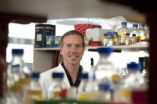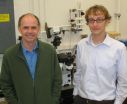(Press-News.org) Scientists from the Walter and Eliza Hall Institute have identified the key immune cell population responsible for regulating the body's immune response.
The finding could have wide-ranging repercussions for the treatment of autoimmune diseases, organ transplantation and cancer, and change how the efficacy of newly developed drugs is measured.
The discovery was made by Dr Erika Cretney, Dr Axel Kallies and Dr Stephen Nutt from the institute's Molecular Immunology division. It centred on a population of immune cells called regulatory T cells.
Regulatory T cells (T-regs) are responsible for limiting the immune response. Disorders that decrease T-reg activity can lead to autoimmune disorders such as type 1 diabetes or coeliac disease, while increased T-reg activity can suppress the immune system when it should be actively killing cancerous or infected cells.
Dr Kallies said the research team had used molecular signatures to identify which cells within the regulatory T cell population were responsible for suppressing immune responses.
"It turns out that the bulk of cells which are classified as regulatory T cells may not do much," Dr Kallies said. "In this study we have identified a distinct group of effector regulatory T cells, or 'active T-regs', which are the key drivers of immune response regulation."
Dr Nutt said the research had implications for clinical trial outcomes.
"Researchers often measure regulatory T cell numbers in clinical trials as a parameter for establishing whether there has been a positive immune response," Dr Nutt said. "We have shown that the absolute number of regulatory T cells isn't as important as the presence of this particular active regulatory T cell population."
Dr Nutt said the research showed that mice without active T-reg cell populations developed severe autoimmune inflammatory bowel disease, which is fatal.
"Not having this T cell population in the gut causes the immune response to go into overdrive and attack the body's own cells," he said. "A lack of the factor that is needed to generate active T-reg cells has also been implicated in human genome-wide studies of Crohn's disease. So it would seem that this cell population is strongly linked to the development of autoimmunity."
Dr Cretney said that re-defining the active subset of the T-reg population would give researchers the ability to develop new ways to increase or block their activity in the body. "The next step for my research is to look at the function of this active T-reg population in autoimmunity and in cancer."
Dr Kallies said that for these reasons, there was a lot of excitement in the medical community about regulatory T cells. "Clinicians have shown that regulatory T cell activity impacts on many therapies," he said. "Many research teams are trying to manipulate and expand these cells for therapeutic use. Our finding will transform the way that researchers look at immune responses and open new avenues for treating diseases such as autoimmunity and cancer."
INFORMATION:
The research appears on the cover of today's edition of Nature Immunology. It was supported by the National Health and Medical Research Council, the Australian Research Council and Pfizer Australia.
Newly identified cell population key to immune response
2011-03-07
ELSE PRESS RELEASES FROM THIS DATE:
Japanese scientists use alcoholic drinks to induce superconductivity
2011-03-07
Japanese researchers have been immersing iron-based compounds in hot alcoholic beverages such as red wine, sake and shochu to induce superconductivity.
Scientists from the National Institute for Materials Science, Japan, found that immersing pellets of an iron-based compound in heated alcoholic beverages for 24 hours greatly increase their superconducting ability.
Iron-based compounds usually become superconductive after being exposed to air. This process however can take up to several months. This study demonstrated that superconductivity can be induced in just one ...
Re-formulation of microbicidal lubricants will help protect from HIV
2011-03-07
Microbicides can be used to protect against HIV, and other sexually transmitted diseases, either on their own or with the added protection of a condom. New research published by BioMed Central's open access journal AIDS Research and Therapy has investigated the use of lubricants, originally designed for vaginal application, and has developed and tested new, rectal specific, formulations.
Unprotected sex is one of the major ways that HIV spreads through the population. However most research has focused on the production of vaginal microbicides which, due to differences ...
International collaborative identifies 13 new heart-disease-associated gene sites
2011-03-07
An international research collaboration has identified 13 new gene sites associated with the risk of coronary artery disease and validated 10 sites found in previous studies. Several of the novel sites discovered in the study, which is being published online in Nature Genetics, do not appear to relate to known risk factors, suggesting previously unsuspected mechanisms for cardiovascular disease.
"We now have identifed 23 specific genetic 'letters' that appear to confer risk for myocardial infarction and other aspects of coronary artery disease," says Sekar Kathiresan, ...
Cardiac catheter that can do it all
2011-03-07
In an improvement over open-heart surgery, cardiologists now use catheters to eliminate damaged heart tissue in certain patients, such as those with arrhythmias. But this, too, can be a long and painful procedure as many catheters, with different functions, need to be inserted sequentially.
Now an interdisciplinary team including researchers from Northwestern University has developed one catheter that can do it all. This tool for cardiac ablation therapy has all necessary medical devices printed on a standard balloon catheter: a device for eliminating damaged tissue using ...
Scripps Research scientists develop new test for 'pluripotent' stem cells
2011-03-07
LA JOLLA, CA – "Pluripotent" stem cells—which have the potential to mature into almost any cell in the body—are being widely studied for their role in treating a vast array of human diseases and for generating cells and tissues for transplantation. Now, a team of Scripps Research Institute scientists has created a quality control diagnostic test that will make it much easier for researchers to determine whether their cell lines are normal pluripotent cells.
The study was published in an online version of Nature Methods on March 6, 2011.
"Many scientists are unhappy ...
New instrument keeps an 'eye' on nanoparticles
2011-03-07
(Santa Barbara, Calif.) –– Precision measurement in the world of nanoparticles has now become a possibility, thanks to scientists at UC Santa Barbara.
The UCSB research team has developed a new instrument capable of detecting individual nanoparticles with diameters as small as a few tens of nanometers. The study will be published on line this week by Nature Nanotechnology, and appear in the April print issue of the journal.
"This device opens up a wide range of potential applications in nanoparticle analysis," said Jean-Luc Fraikin, the lead author on the study. ...
Sleepy connected Americans
2011-03-07
About two-thirds of baby boomers (67%) and generation X'ers (63%) and half of generation Z'ers (50%) and generation Y'ers (49%) watch television every night or almost every night within the hour before going to sleep.
"Artificial light exposure between dusk and the time we go to bed at night suppresses release of the sleep-promoting hormone melatonin, enhances alertness and shifts circadian rhythms to a later hour—making it more difficult to fall asleep," says Charles Czeisler, PhD, MD, Harvard Medical School and Brigham and Women's Hospital. "This study reveals that ...
'Fat Tuesday' is 'Phat Newsday' at BrianGeary.com
2011-03-07
BrianGeary.com will celebrate 'Fat Tuesday' with a 'Phat Newsday' on March 8th, 2011. The tradition of Mardi Gras will be celebrated by allowing clients to fatten their wallets with a 50% savings on news releases. Long-time and first-time clients are invited to take advantage of this savings before it is swept away at midnight (Pacific Standard Time).
"It's easy to get so caught up in Carnival," explains spokesman Brian Geary, "that businesses postpone their news announcements until the festivities are over." This often contributes to an anemic pipeline and subsequent ...
Yara Annechiarico of At Home with Yara Realty
2011-03-07
For those who are asking for my housing market predictions want me to reassure them that their homes will soon be worth again what they were worth in recent past years.
Unfortunately, when it comes to making housing market predictions, what I'm hearing from the National Association of Realtor's is that there are no easy answers Short sales & Loan modifications are still a painful process; Foreclosures are going to continue at these levels for awhile & Unemployment level are still on an average high.
Over all this is still the best time to buy if you're able to considering ...
National Juris Solutions Has Advanced Software
2011-03-07
National Juris Solutions has developed state of the art legal software that provides practice management, time/billing, and accounting - all designed specifically for law firms. With one program, you'll meet all your case management, document handling, messaging, time recording, legal billing, and law firm accounting requirements. Duplication of data entry is eliminated and entry errors are significantly reduced, dramatically lowering your malpractice risks and giving you more time to spend on billable tasks.
No need for a separate calendaring, contact, case, and legal ...

